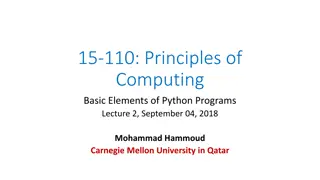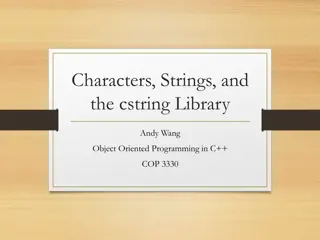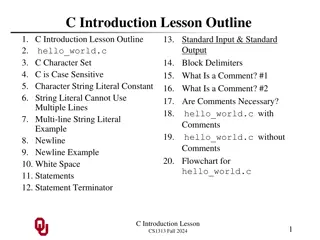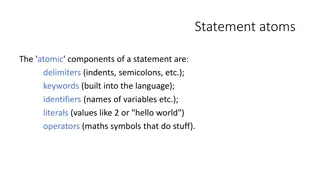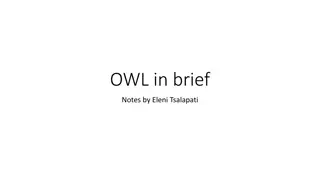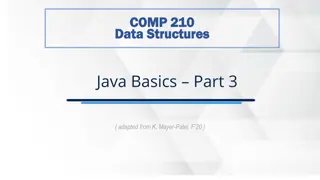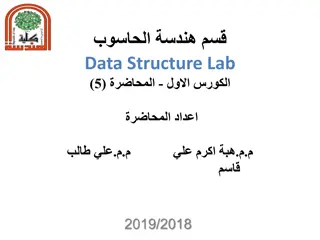Introduction to Intel Assembly Language for x86 Processors
Intel Assembly Language is a low-level programming language designed for Intel 8086 processors and their successors. It features a CISC instruction set, special purpose registers, memory-register operations, and various addressing modes. The language employs mnemonics to represent instructions, with
2 views • 12 slides
Understanding Basic Elements of Python Programs
Explore the fundamental aspects of Python programming such as literals, assignments, datatype conversion, identifiers, and expressions. Learn how to work with variables, values, and simple Python commands effectively.
0 views • 38 slides
Exploring Characters, Strings, and Cstring Library in C++
This content delves into the usage of characters, strings, and the cstring library in C++. Covering topics such as C-style strings, character literals, array functions, conversion functions, query functions, string I/O operations, and more, it provides a comprehensive overview essential for masterin
0 views • 25 slides
C Introduction Lesson Overview and Basics Summary
This text provides an overview of a C programming lesson, covering topics such as the character set, case sensitivity, string literals, comments, standard input and output, and more. It includes code snippets and explanations to help beginners understand fundamental concepts of C programming.
0 views • 20 slides
Overview of GeoSPARQL Implementation in Parliament
Explore the GeoSPARQL implementation in Parliament, a triple store with SPARQL support used for over a decade. Learn about its design, indexing strategy, spatial features, and missing components compared to GeoSPARQL standards. Discover how Parliament supports GML and WKT literals, various spatial r
0 views • 12 slides
Understanding Statement Atoms and Basic Syntax in Programming
The atomic components of a statement include delimiters, keywords, identifiers, literals, and operators. Basic syntax involves single-line statements, inline and block comments, and compound statements categorized by control flow markers. Different languages have distinct ways of structuring code, s
0 views • 12 slides
Understanding Strings in Programming
Strings are essential in programming for representing various data types, languages, and programs. They offer unique features like slicing, ranges, and comprehensions. This article explores string literals, different forms of strings, similarity to lists, differences between lists and strings, and s
0 views • 34 slides
Understanding Web Ontology Language (OWL) in a Nutshell
Web Ontology Language (OWL) is a powerful tool for ontology modeling, allowing the creation of complex structures and relationships. OWL encompasses entities, expressions, and properties, enabling detailed descriptions of domains through axioms. The language supports both object and data properties,
0 views • 39 slides
Basics of Java Arrays and Array Manipulation
Learn about the fundamentals of Java arrays, including initialization, literals, indexing, and the special value of null. Explore how arrays function as reference types and how array cloning can be used to create shallow copies. Understand the implications of passing arrays to methods and how change
0 views • 44 slides
Understanding Constants and Literals in C++ Programming
Constants and literals in C++ are fixed values that the program cannot alter. They come in various types such as integer numerals, floating-point numerals, characters, strings, and boolean values. Integer literals can be decimal, octal, or hexadecimal constants, while floating-point literals have in
0 views • 7 slides

